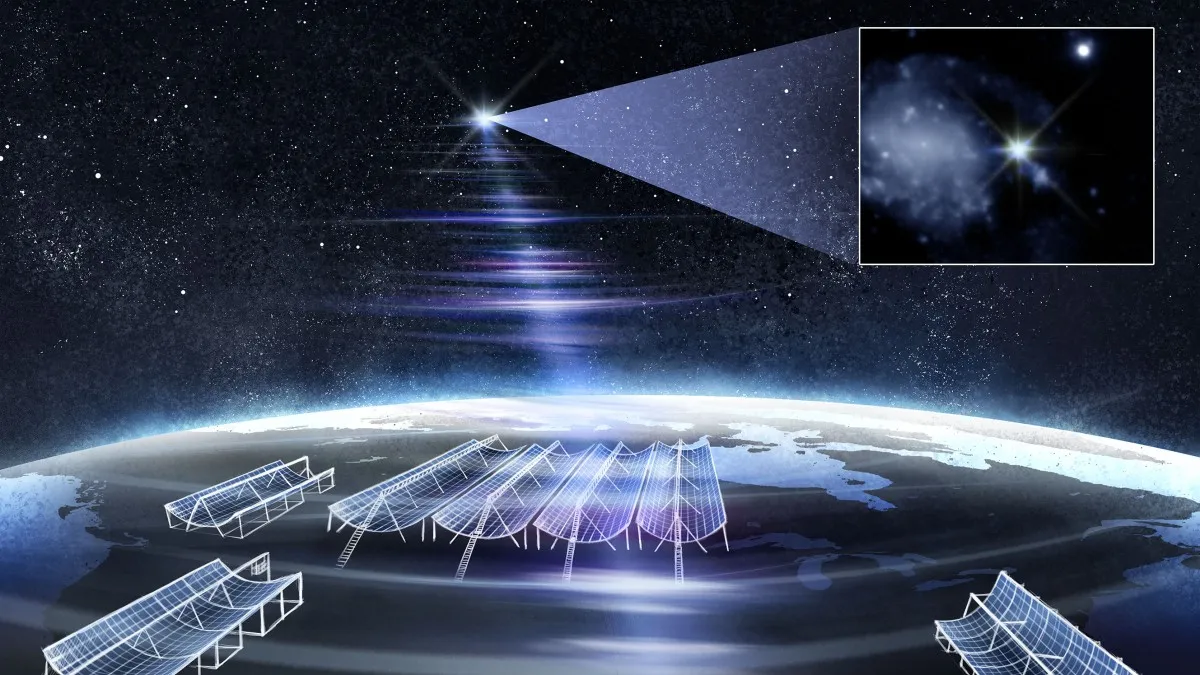
For the first time, scientists have utilized the James Webb Space Telescope (JWST) to investigate the origins of a peculiar and record-breaking radio signal that passed by Earth earlier this year. Researchers successfully tracked this bright radio burst to the edge of a galaxy approximately 130 million light-years away from our planet. Using JWST's advanced infrared capabilities, they identified a powerful explosion of energy emanating from a large, ancient star, which may be the progenitor of this mysterious signal.
The research team also focused on specific stars clustered in the vicinity of the radio burst, painting a detailed picture of the environment from which this fast radio burst (FRB) originated. Their findings, detailed in two papers published on August 21 in The Astrophysical Journal Letters, signify a potential turning point in the study of FRBs, which have historically presented significant challenges for researchers trying to trace their origins back to their respective galaxies, and even more so to the specific star systems that produced them.
Peter Blanchard, a research scientist at Harvard University and lead author of one of the papers, stated, “The high resolution of JWST allows us to resolve individual stars around an FRB for the first time. This opens the door to identifying the kinds of stellar environments that could give rise to such powerful bursts, especially when rare FRBs are captured with this level of detail.”
True to their name, fast radio bursts are incredibly brief pulses of radio energy, often lasting only a few milliseconds. Despite their short duration, they emit more power in that time than the sun does over several days. Since their discovery in 2007, over 1,000 FRBs have been detected from various regions across the sky. However, the fleeting nature of these signals complicates research efforts. While many of these strange signals repeat, others do not, leading to various theories about their origins. The leading hypothesis suggests that magnetars—fast-spinning, highly magnetized remnants of dead stars known as neutron stars—are the primary source of these bursts, although this remains uncertain.
In March, astronomers at the Canadian Hydrogen Intensity Mapping Experiment (CHIME) identified the single brightest radio burst ever recorded at their facility. Officially designated as FRB 20250316A, this powerful burst was nicknamed RBFLOAT, short for Radio Brightest Flash Of All Time. The burst's extreme brightness suggested it originated relatively close to the Milky Way, making it an ideal target for CHIME's new Outrigger array, a collection of telescopes spanning North America, from California to British Columbia.
By studying the powerful FRB from multiple perspectives, researchers pinpointed its location to the galaxy NGC 4141, situated within the Big Dipper. They further narrowed the origin of the burst to a specific area of space measuring just 45 light-years across. To put this into perspective, our Milky Way galaxy is about 100,000 light-years in diameter. Amanda Cook, a postdoctoral researcher at McGill University and lead author of the second paper, remarked on the precision of this localization, stating that it is akin to spotting a quarter from 100 kilometers (62 miles) away.
Following CHIME's initial findings, the research team enlisted the help of the powerful JWST to closely examine the narrow region of space where RBFLOAT originated. The telescope not only detected an infrared energy burst at the precise location of the FRB but also analyzed individual stars in the surrounding neighborhood to better understand the environment from which the radio burst originated. Blanchard noted, “This could be the first object linked to an FRB that anyone has found in another galaxy.”
Data from JWST indicated that the infrared object is likely either a red giant star—a star that has expanded as it approaches the end of its life—or a massive middle-aged star significantly larger than the sun. Although neither type of star is a direct source of FRBs, the team suggested that an unseen companion star, potentially an energy-emitting neutron star, could be orbiting the infrared object. This interaction might have triggered the bright radio burst.
By examining the surrounding environment, rich with young but massive stars, the research team proposed a second hypothesis: one of the larger stars in the cluster may have already collapsed into a magnetar, a scenario that could easily account for the emitted FRB while remaining too faint to be directly observed with JWST. Blanchard summarized their findings by stating, “Whether or not the association with the star is real, we've learned a lot about the burst's origin.”
Regardless of whether a double star system is responsible, this research underscores the enhanced capability of the newly upgraded CHIME experiment in localizing elusive FRBs with unprecedented precision. Moreover, the collaboration with JWST highlights the telescope's vital role in the ongoing quest to understand these enigmatic cosmic phenomena. Continued tracking of FRBs to their origins will not only address one of the most significant mysteries in astrophysics but could also provide new insights into stellar dynamics, revealing how different stars evolve throughout their luminous yet tumultuous lifetimes.